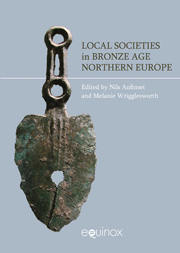Book contents
- Frontmatter
- Contents
- List of figures and tables
- Contributors
- Acknowledgements
- Introduction: local societies, regions and processes of cultural interaction in the Bronze Age
- PART I IDENTITY, GRAND NARRATIVES AND NETWORKS
- 1 Approaching a complex past: entangled collective identities
- 2 Asymmetric twins? Some reflections on coastal and inland societies in the Bothnian area during the Epineolithic and Early Metal Age
- 3 Expressing identity through ritual in the Early Bronze Age
- 4 Large-scale “grand narratives” and small-scale local studies in the Bronze Age discourse: the animal perspective
- 5 Reconsidering a periphery: scenarios of copper production in southern Norway
- 6 On the bronze trail: short-cuts, byways, transformation and displacement
- PART II REGIONS, GLOBALIZATION AND RESISTANCE
- Index
2 - Asymmetric twins? Some reflections on coastal and inland societies in the Bothnian area during the Epineolithic and Early Metal Age
from PART I - IDENTITY, GRAND NARRATIVES AND NETWORKS
- Frontmatter
- Contents
- List of figures and tables
- Contributors
- Acknowledgements
- Introduction: local societies, regions and processes of cultural interaction in the Bronze Age
- PART I IDENTITY, GRAND NARRATIVES AND NETWORKS
- 1 Approaching a complex past: entangled collective identities
- 2 Asymmetric twins? Some reflections on coastal and inland societies in the Bothnian area during the Epineolithic and Early Metal Age
- 3 Expressing identity through ritual in the Early Bronze Age
- 4 Large-scale “grand narratives” and small-scale local studies in the Bronze Age discourse: the animal perspective
- 5 Reconsidering a periphery: scenarios of copper production in southern Norway
- 6 On the bronze trail: short-cuts, byways, transformation and displacement
- PART II REGIONS, GLOBALIZATION AND RESISTANCE
- Index
Summary
Introduction
Culture-historical archaeology has to a large degree been based on the conceptual linking of culture and people. This is often seen as a relationship between groups living in a continuous area exhibiting a similar culture. Focus has to a great degree been on within-area similarities and between-area dissimilarities in material culture. This has produced archaeological cultures represented as plateaus of low variability bordered by zones with rapidly changing material culture. Groups are seen as cultural groups with large internal cohesion and contact, whereas contacts with “outsiders” are much less frequent. Culture is seen as normative and shared, based on ideas and bounded in space and time (Childe 1957; Hodder 1982: 1–12, 1991: 1–22). In archaeology it has often been based on gross groups of ceramic, lithic or metalwork styles. This paradigm evidently has a background in the analogy with nation states and their “people”, das Volk.
At the same time, archaeologists have also been interested in society, which has been defined as groups of people involved in frequent interaction. This view was earlier seen in an evolutionary perspective, where different types of society were replacing each other, with the replacement society being more advanced and complex than the preceding one. In the 1960s and 1970s much research concentrated on the different levels of social organization and the transitions between them, creating the problem of how to explain cultural change (Service 1962; Fried 1967; Johnson & Earle 2000).
- Type
- Chapter
- Information
- Local Societies in Bronze Age Northern Europe , pp. 31 - 55Publisher: Acumen PublishingPrint publication year: 2012



